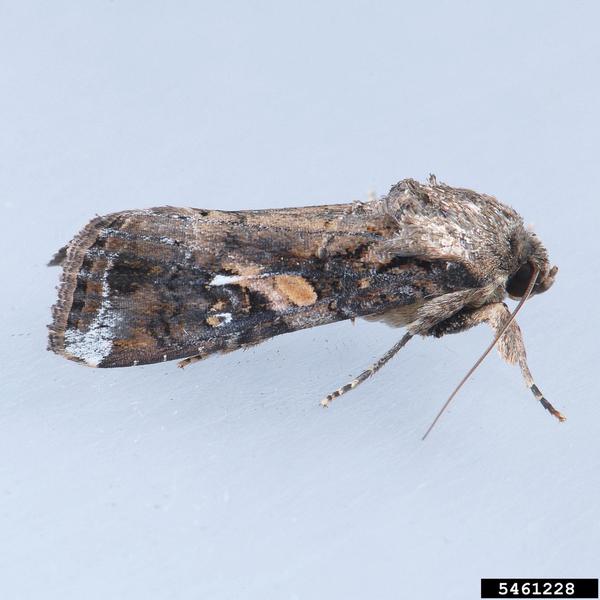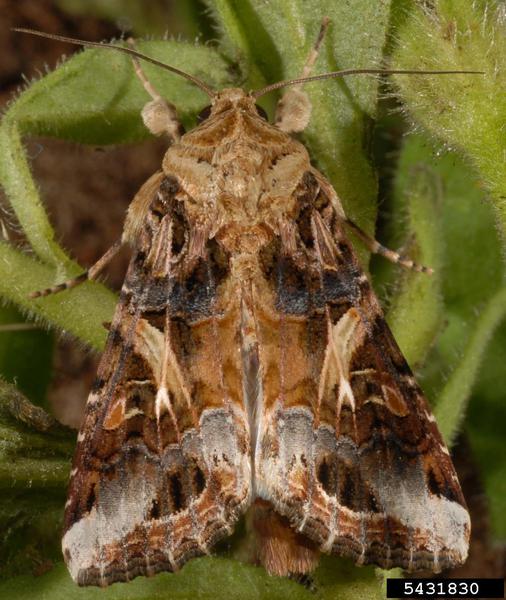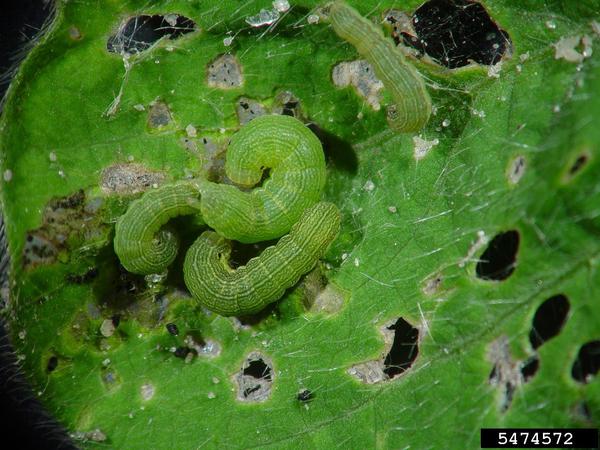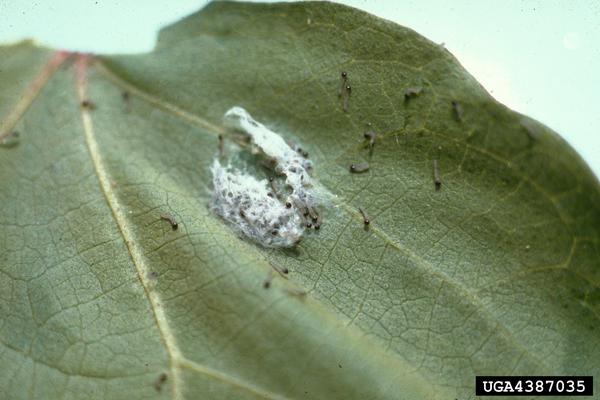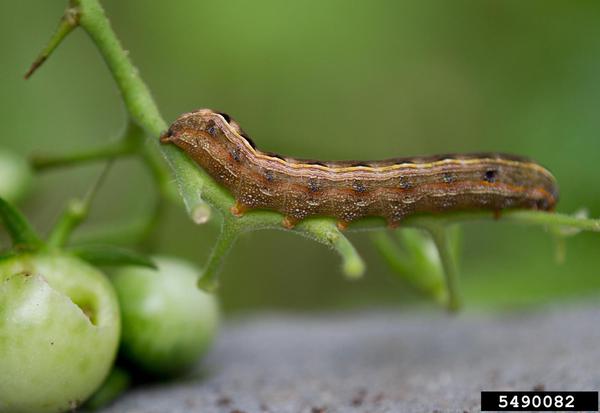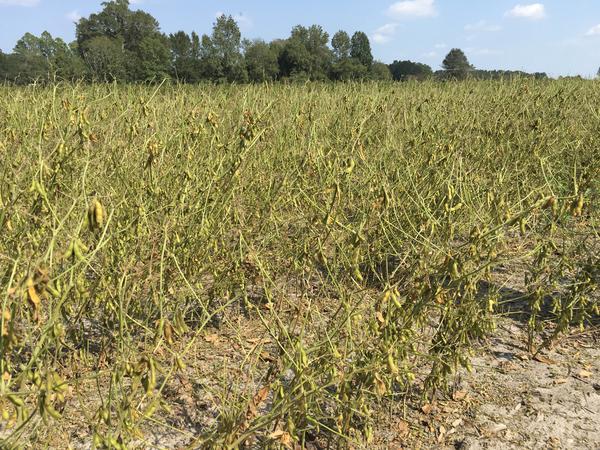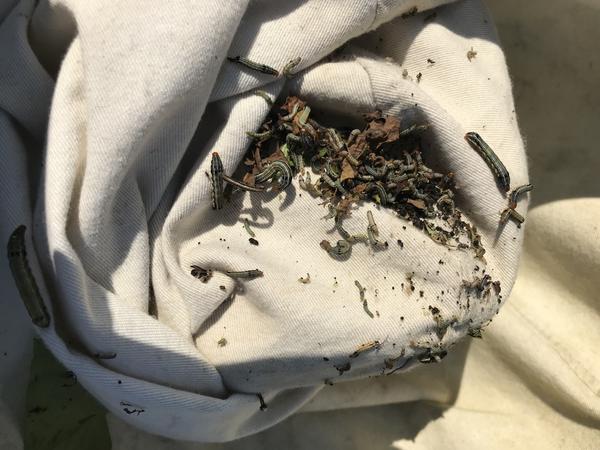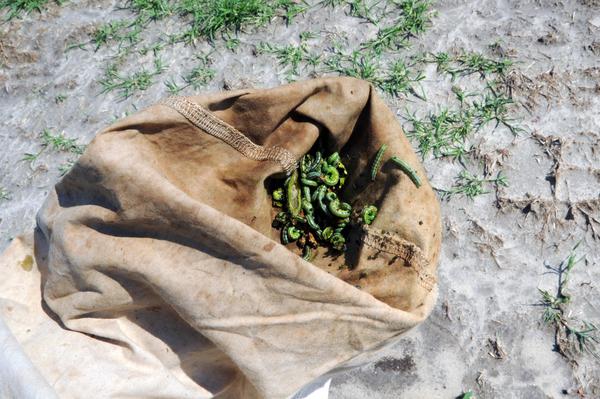Armyworms (Multiple Species)
Spodoptera exigua Hübner, Spodoptera frugiperda J. E. Smith, and Spodoptera ornithogalli Guenée.
Biology and Identification
Beet armyworm (Spodoptera exigua Hübner) caterpillar larvae are olive-green to near black and smooth, with a stripe down each side. A black spot appears on each side, just above the second pair of legs behind the head; there are three pairs of legs near the head, and four pairs of legs near the back plus a pair of legs directly at the back (4 + 1). Larvae fall and curl up into a “C” when disturbed. Small larvae web the underside of the leaf.
Fall armyworm (Spodoptera frugiperda J. E. Smith) caterpillar larvae are olive-green to dark brown and smooth, with a dark band above a stripe running down each side. The head is dark brown with a distinct cream-colored upside-down “Y” separating the eyes on either side of the head. Although corn earworm larvae also have an upside-down “Y” on the head, four black spots arranged in a square pattern appear on the top of the body near the rear of fall armyworm larvae. These are not present in corn earworm larvae. Fall armyworm larvae have three pairs of legs near the head and four pairs of legs near the back plus a pair of legs directly at the back (4 + 1).
Yellowstriped armyworm (Spodoptera ornithogalli Guenée) caterpillar larvae are pale gray to velvety black, with a yellow or yellowish-orange stripe running down each side. Above the stripe, a black triangular spot is found on nearly every segment of the body. Like the fall armyworm, a distinct cream-colored upside-down “Y” separates the eyes on either side of the head. Small black spots appear on each side of the first abdominal segment, further toward the rear compared with the side spots on the beet armyworm. There are four pairs of legs near the head plus a pair of legs near the back (4 + 1).
Both beet armyworm and fall armyworm are migratory insects and, as a result, are more prevalent later in the season. Yellowstriped armyworm overwinters in North Carolina and can be found throughout the season. Armyworms have multiple generations.
Injury and Damage
Although yellowstriped armyworm can be found throughout the season, it only sporadically injures soybeans and generally in young stands. In contrast, the beet armyworm and fall armyworm mainly affect late-planted seedling soybeans, and can be serious pests. Small larvae skeletonize the lower leaves. Large larvae feed over the whole plant. Severely damaged plants are very ragged in appearance. Beet armyworms often feed on and defoliate pigweed plants in and around soybean fields. They can also produce webbing that may be present on the underside of leaves. Noticing such damage can alert the scout that beet armyworm caterpillars may be present and moving toward a soybean field.
Economic Threshold
The threshold for defoliating insects is 30% defoliation throughout the plant canopy two weeks prior to blooming (R1) and 15% defoliation throughout the plant canopy two weeks prior to flowering (stage varies) until the pods have filled (R7-R8). Vegetative soybeans are tolerant of feeding and, as seedlings become larger and faster growing, this foliage loss is seldom of concern. Recent studies have demonstrated that soybeans can tolerate nearly 100% foliage loss during the early vegetative stages before yield loss is achieved.
Management
Recommended insecticides can be found in the North Carolina Agricultural Chemicals Manual. Note that both beet armyworm and fall armyworm have resistance to some insecticide classes and these are reflected in the insecticides listed in the manual for each insect.
Publication date: April 7, 2020
Reviewed/Revised: Jan. 9, 2025
N.C. Cooperative Extension prohibits discrimination and harassment regardless of age, color, disability, family and marital status, gender identity, national origin, political beliefs, race, religion, sex (including pregnancy), sexual orientation and veteran status.


